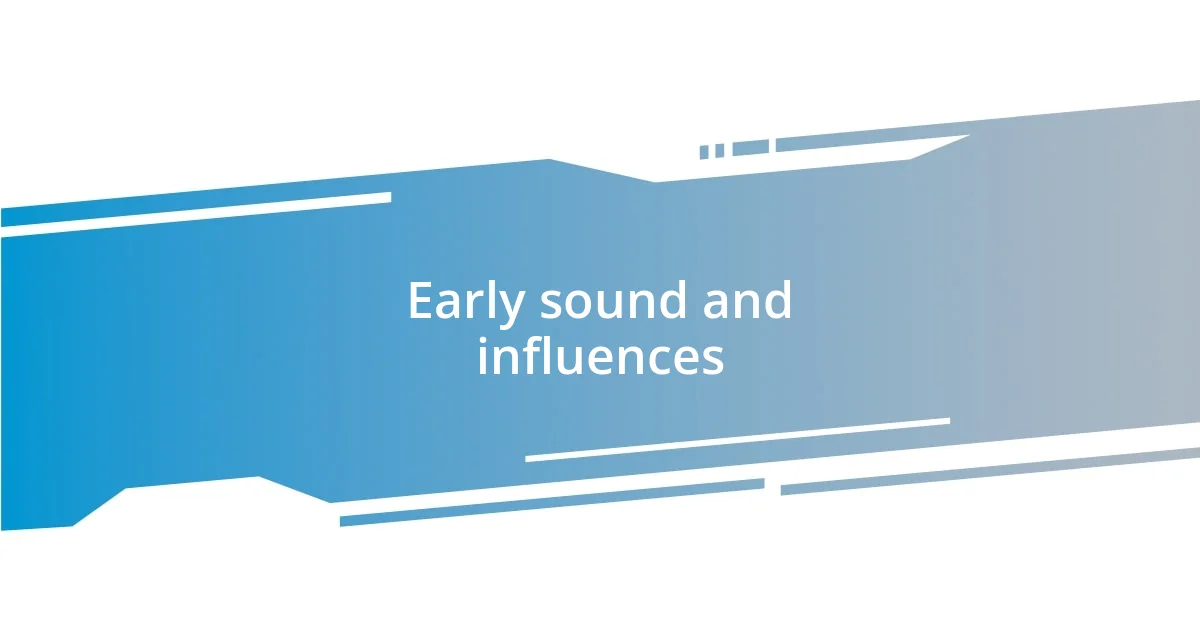Key takeaways:
- The author’s emotional connection to Foo Fighters began in high school with “Everlong,” evolving alongside key albums that resonated with personal experiences.
- Foo Fighters’ sound has evolved significantly from their grunge roots, showcasing emotional depth and authenticity through albums like “The Colour and the Shape,” “One by One,” and “Wasting Light.”
- Live performances created memorable experiences that reinforced the band’s bonds with fans, demonstrating their growth not just in music but also in meaningful engagement with their audience.

My journey with Foo Fighters
My journey with Foo Fighters began in high school when I stumbled upon “Everlong.” I remember listening to it for the first time and feeling an overwhelming rush of nostalgia mixed with hope. It was like the song met me exactly where I was in my life, tugging at my heartstrings and reminding me of a budding first love.
As I explored more of their music, it felt like a soundtrack to my life. Each album brought something new, reflecting the phases I was going through. “The Colour and the Shape” spoke to my adolescent angst, while “Wasting Light” captured my desire to break free from conformity. Have you ever had an album that felt like it whispered the secrets of your soul? With Foo Fighters, I found my emotions voiced in ways I didn’t know were possible.
Over the years, I witnessed not just the evolution of their sound but also the evolution of myself as a fan. Songs like “Walk” became anthems of resilience for me during challenging times. I remember screaming the chorus at the top of my lungs, feeling empowered and invincible. It prompts me to wonder: how many of us have moments like that, where music becomes a lifeline? Foo Fighters have been there for me through thick and thin, shaping my taste, my moods, and even my friendships.

Early sound and influences
The early sound of Foo Fighters was undeniably rooted in the grunge and post-grunge sound of the ’90s, influenced by the music of bands like Nirvana and Seattle’s rock scene. I can still vividly recall the raw energy that radiated from tracks like “This Is a Call” and “I’ll Stick Around.” They captured that intense emotional landscape, blending catchy hooks with powerful guitar riffs, making it impossible not to feel connected to the music. I felt like I shared a secret camaraderie with other fans, bonding over those lyrical nuances that spoke to our shared experiences.
Here are some key influences that shaped their early sound:
- Nirvana’s Grunge Legacy: As Dave Grohl transitioned from drummer to frontman, his roots in Nirvana profoundly influenced his songwriting.
- Alternative Rock Surge: Bands like Pearl Jam and Soundgarden pioneered a new rock wave that resonated with their aesthetic.
- Post-Hardcore Elements: The incorporation of raw energy and emotional honesty set a tone for many early Foo Fighters tracks.
- Melodic Sensibility: Their knack for blending sweet melodies with powerful instrumentation created an anthemic feel that was both accessible and profound.
When I first heard their self-titled debut album, I remember being struck by how intimately I could relate to the struggles depicted in those songs—it felt like Grohl was articulating my own feelings of isolation and yearning. That sense of connection is what drew me in and solidified my loyalty to the band.

Key albums and their evolution
The evolution of Foo Fighters’ sound is beautifully encapsulated in their key albums. Starting with “The Colour and the Shape,” I was captivated by the dramatic shift from their debut. Tracks like “My Hero” and “Everlong” had this emotional depth that resonated with my experiences, especially during those tumultuous years. It was as if each chord struck the right balance of vulnerability and strength, inviting me to explore my own feelings of love and loss.
As we moved into “One by One,” I noticed a more polished production that still maintained an edge. Songs like “All My Life” surged with a raw intensity, reflecting not only the band’s growing confidence but also my personal journey through adulthood. I often listened to it while driving late at night, feeling that exhilarating rush as I sang along, tapping into a sense of freedom that was hard to find elsewhere. It made me realize: music truly captures those fleeting moments of clarity.
Then came “Wasting Light,” which reignited my passion for the band. This album felt like a celebration of everything they had been through, and it connected with me on a profound level. The authenticity of “Walk” and the nostalgia of “These Days” sparked reflections on my own growth. I recall attending a concert during this era; the electrifying atmosphere made me feel like part of something bigger. It hit me how Foo Fighters’ sound had evolved alongside my own life experiences, transforming my perspective along the way.
| Album | Key Characteristics |
|---|---|
| The Colour and the Shape | Emotional depth, anthems of love and loss |
| One by One | Polished production, raw intensity |
| Wasting Light | Authenticity, a celebration of growth |

Notable changes in musical style
While the early Foo Fighters sound blasted through the speakers with that grunge-infused energy, their style began to take a distinct turn around the time of “The Colour and the Shape.” I remember the first time I heard “Everlong”—it was like an emotional tidal wave washing over me, blending tenderness with a sense of urgency that made me reflect on my relationships. The lyrics wrapped around me like a warm blanket, prompting conversations with friends about our own heartbreaks and hopes. It was fascinating to see how their sound evolved into something more nuanced, where each album felt like a new chapter in an unfolding story.
As they transitioned into “One by One,” I could feel the band exploring even more dynamic terrain. Songs like “Times Like These” captured that bittersweet feeling of resilience, reminding me of the uncertainty we all face. I found myself humming it during a tough stretch in my career, as if Grohl was giving voice to those moments of doubt that we all grapple with. That polished approach didn’t strip the music of its soul; rather, it added another layer, inviting me to dive deeper into the emotional landscape.
The shift toward a more raw, authentic sound in “Wasting Light” resonated with me on a personal level. It felt like the band was reclaiming their roots, creating music that was stripped down and genuine. When I first heard “Walk,” I found myself reflecting on my own journey of growth, as if Grohl was both cheering me on and sharing in my struggles. Every note took me back to pivotal moments in my life, encouraging a sense of connection that reminded me: sometimes, the best way to navigate life’s ups and downs is through the catharsis of music. It was a clear reminder that Foo Fighters didn’t just evolve as a band; they grew with us, sharing a soundtrack to our lives.

Impact of band lineup changes
The changes in Foo Fighters’ lineup have profoundly impacted their sound and, quite honestly, how I connect with their music. When I learned about the departure of founding member and guitarist, Franz Stahl, I felt a mixture of curiosity and apprehension. Would the band’s essence change? As I listened to the subsequent albums, I could sense fresh influences creeping in, especially in songs like “Times Like These.” It was intriguing to witness how Grohl and the team adapted, almost reinventing themselves while still holding onto that familiar energy.
With the later addition of Chris Shiflett, the guitar work took on a new dimension, enriching the melodies in a way that made my heart soar. I recall driving down winding roads with “The Pretender” blasting from my speakers; it seemed as if his contribution added fuel to Grohl’s fire. The angular riffs and harmonies lifted the overall experience and made those moments feel alive—enthralling yet grounded. It raised a question in my mind: how does a band transform its sound while maintaining the core of who they are? For me, it felt like a delicate balance, one that Foo Fighters navigated with grace.
As Pat Smear returned to the fold, the band’s chemistry surged. I distinctly remember the first time I heard “Something From Nothing” live; the energy in the venue was palpable, and I could see the band thriving together again. There was an undeniable warmth that came from their camaraderie, and I couldn’t help but reflect on how essential that is for creative evolution. This made me realize that lineup changes aren’t just about instruments or vocals—they embody the spirit of collaboration that fuels artistic growth. Each shift in members brought a unique flavor, and I, like so many fans, embraced this dynamic journey as a testament to their resilience and passion for music.

Memorable live performances and tours
There’s something unforgettable about witnessing Foo Fighters live; each concert feels like a celebration of the very essence of rock. I vividly remember standing in the crowd during their performance at Lollapalooza. The electric atmosphere, amplified by Grohl’s magnetic energy, created a bond among us all. When they hit the first notes of “My Hero,” the entire audience erupted in a chorus, and it struck me how music can unite strangers, turning us into a single entity. Have you ever felt that moment where the sound wraps around you, making you forget everything outside that arena?
During their “Wasting Light” tour, I experienced a rawness that brought back memories—every chord struck a familiar chord within me. I saw them in a smaller venue, and it felt as if the band was right there with us, sharing a private moment. I recall Grohl stopping mid-set to connect with the fans, asking about their stories. It was this blend of sincerity and rock-star charisma that made me appreciate the band even more; they weren’t just performing, they were creating an experience. It makes me wonder: as artists evolve, do they ever lose sight of that intimate connection with their fans?
Then there was the “Sonic Highways” tour, where each city brought a new flavor to their sound. I remember the band paying tribute to local legends, weaving in stories that made my skin prickle with excitement. It was like attending a rock history lesson wrapped in a high-energy concert. I felt a profound sense of gratitude that Foo Fighters were not just sharing their music but celebrating the places that shaped them. How incredible is it that a single concert can echo the stories of an entire city while intertwining with the band’s journey? Those moments made me realize that their evolution goes beyond studio albums; it’s about how each performance connects the past with the present, creating a vibrant tapestry of sound and emotion.

Personal reflections on their growth
I’ve always been fascinated by how Foo Fighters have grown from their early days to what they are now. One night, I sat with friends in our living room, revisiting their self-titled debut and then jumping to “Wasting Light.” The difference was staggering! That raw, almost reckless energy of their first album had transformed into this powerful, polished sound full of depth. It made me realize how influential their journey through different styles has been—each album feels like a snapshot of their evolution, both musically and personally.
I remember hearing “Rope” for the first time and feeling a sense of pride for the band. It’s not just another catchy song; the intricate rhythms and layered sounds captivated me. There was a moment when I caught myself humming it at work, which usually just doesn’t happen with newer music for me. This kind of moment sparked a thought: could a band balance old-school rock vibes with modern experimentation so effectively? Foo Fighters did just that, proving that growth doesn’t mean abandoning your roots but rather enriching them.
Reflecting on their later work, particularly “Concrete and Gold,” evokes a sense of nostalgia mixed with excitement. I couldn’t help but feel exhilarated when I caught the album’s premiere show. Those mature themes made me think about my own life—how we’ve all had to evolve through different phases. I felt a sense of connection to their journey; they were still that band willing to experiment, yet they sang about struggle and hope, things we all understand. Isn’t it something special when a band’s growth mirrors our own experiences?
















